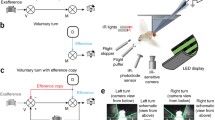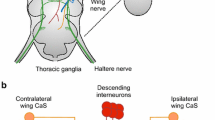Summary
Yaw torque fluctuations ofDrosophila in stationary flight at the torque meter in many cases represent meaningful behavior patterns (e.g., Figs. 4, 9a). In the closed loop situation for rotations around the fly's vertical axisDrosophila stabilizes any panorama by adjusting its “optomotor balance” (e.g., Figs. 2, 3, 8, 11) — a presumably integrative directionally movement sensitive flight control mechanism.
In this state of “harmony” with the environmentDrosophila often performs active turns by means of body-saccades (Fig. 2). In this study these are recorded as “torque spikes” — an elementary motor pattern of typical size and time course (Fig. 3). Their polarity and frequency are dependent upon visual stimulation (Figs. 4, 5, 6).
During a torque spike the fly does not respond to the visual stimulation caused by the relative displacement of the environment (Fig. 13); an artificial displacement in the opposite direction, however, causes a fast vigorous turning response. This is attributed to a directionally selectiveefference copy of the torque spike motor pattern which suppresses the reafferent visual input (Fig. 13a-f). The efference copy also relieves the visual system from certain inhibitory interactions which, in larger flies, have been shown to provide “figure-ground” discrimination (Fig. 13g-l). In addition the asymmetry in the fly's response to progressive and to regressive movement of small patterns is eliminated by the efference copy. Such information processing steps may be of minor importance during body-saccades.
Optomotor balance inDrosophila is the basis of oriented flight. In closed loop experiments with one vertical black stripe the fly spends only part of its time keeping the stripe in its direction of flight (fixation). More often it stabilizes the stripe in other positions (non-fixation) (Fig. 8). Torque responses to the position of objects inDrosophila appear to be centrally controlled. Various situations in which the fly favors fixation (anti-fixation) or non-fixation are described.
Similar content being viewed by others
References
Collett, T.S., Land, M.F.: Visual control of flight behaviour in the hoverfly,Syritta pipiens L. J. comp. Physiol.99, 1–66 (1975a)
Collett, T.S., Land, M.F.: Visual spatial memory in a hoverfly. J. comp. Physiol.100, 59–84 (1975b)
Cosens, D.J., Briscoe, D.: A switch phenomenon in the compound eye of the white-eyed mutant ofDrosophila melanogaster. J. Insect Physiol.18, 627–632 (1972)
David, C.T.: The relationship between body angle and flight speed in free-flyingDrosophila. Physiol. Entomol.3, 191–195 (1978)
Geiger, G., Poggio, T.: On head and body movements of flying flies. Biol. Cybernetics25, 177–180 (1977)
Götz, K.G.: Optomotorische Untersuchung des visuellen Systems einiger Augenmutanten der FruchtfliegeDrosophila. Kybernetik2, 77–92 (1964)
Götz, K.G.: Flight control inDrosophila by visual perception of motion. Kybernetik4, 199–208 (1968)
Götz, K.G.: The optomotor equilibrium of theDrosophila navigation system. J. comp. Physiol.99, 187–210 (1975a)
Götz, K.G.: Hirnforschung am Navigationssystem der Fliege. Naturwissenschaften62, 468–475 (1975b)
Heisenberg, M.: Comparative behavioral studies on two visual mutants ofDrosophila. J. comp. Physiol.80, 119–136 (1972)
Heisenberg, M., Buchner, E.: The rÔle of retinula cell types in visual behavior ofDrosophila melanogaster. J. comp. Physiol.117, 127–162 (1977)
Heisenberg, M., Wonneberger, R., Wolf, R.: optomotor-blindH31 — aDrosophila mutant of the lobula plate giant neurons. J. comp. Physiol.124, 287–296 (1978)
Holst, E. von, Mittelstaedt, H.: Das Reafferenzprinzip (Wechselwirkungen zwischen Zentralnervensystem und Peripherie). Naturwissenschaften37, 464–476 (1950)
Jander, R.: Die optische Richtungsorientierung der roten Waldameise (Formica rufa L.). Z. vergl. Physiol.40, 162–238 (1957)
Land, M.F.: Head movement of flies during visually guided flight. Nature243, 299–300 (1973)
Land, M.F.: Visually guided movements in invertebrates. In: Function and formation of neural systems. Stent, G.S., (ed.), pp. 161–177. Berlin: Dahlem Konferenzen 1977
Land, M.F., Collett, T.S.: Chasing behaviour of houseflies (Fannia cannicularis). J. comp. Physiol.89, 331–357 (1974)
Mittelstaedt, H.: Zur Analyse physiologischer Regelungssysteme. In: Verhandlungen der Deutschen Zoologischen Gesellschaft in Wilhelmshaven 1951. Zool. Anz. Suppl.150, 150–157 (1951)
Pfau, H.K.: Fliegt unsere Schmei\fliege mit Gangschaltung? Naturwissenschaften60, 160–161 (1973)
Pick, B.: Visual pattern discrimination as an element of the fly's orientation behaviour. Biol. Cybernetics23, 171–180 (1976)
Poggio, T.: Visually guided movements (Group report). In: Function and formation of neural systems. Stent G.S., (ed.), pp. 309–327. Berlin: Dahlem Konferenzen 1977
Poggio, T., Reichardt, W.: Considerations on models of movement detection. Kybernetik13, 223–227 (1973)
Poggio, T., Reichardt, W.: Nonlinear interactions underlying visual orientation behavior of the fly. Cold Spring Harbor Symp. Quant. Biol.40, 635–645 (1976a)
Poggio, T., Reichardt, W.: Visual control of orientation behavior in the fly. II: Towards the underlying neural interactions. Q. Rev. Biophys.9, 377–438 (1976b)
Reichardt, W.: Musterinduzierte Flugorientierung. Verhaltens-Versuche an der FliegeMusca domestica. Naturwissenschaften60, 122–138 (1973)
Reichardt, W.: Figure-ground discrimination by the visual system of the fly. In: Theoretical approaches to complex systems. Heim, R., Palm, G. (eds.) pp. 117–146. Berlin, Heidelberg, New York: Springer 1977
Reichardt, W., Poggio, T.: Visual control of orientation behaviour in the fly. I: A quantitative analysis. Q. Rev. Biophys.9, 311–375 (1976)
Richmond, B.J., Wurtz, R.H.: Visual responses during saccadic eye movement: A corrolary discharge to superior colliculus. Society for Neurosciences, Abstract 1834 (1977)
Robinson, D.L., Wurtz, R.H.: Use of an extraretinal signal by monkey superior colliculus neurons to distinguish real from self-induced stimulus movement. J. Neurophysiol.39, 852–870 (1976)
Sperry, R.W.: Neural basis of the spontaneous optokinetic response produced by visual inversion. J. Comp. Physiol. Psychol.43, 482–499 (1950)
Wehner, R.: Pattern modulation and pattern detection in the visual system of Hymenoptera. In: Information processing in the visual system of arthropods. Wehner, R. (ed.), pp. 183–194. Berlin, Heidelberg, New York: Springer 1972
Zimmermann, G.: Der Einflu\ stehender und bewegter Musteranteile auf die Optomotorische Reaktion der FliegeDrosophila. Dissertation, Eberhard-Karls-Universität, Tübingen (1973)
Author information
Authors and Affiliations
Additional information
We wish to thank J. Blondeau, K.-F. Fischbach, K.G. Götz, M.F. Land, E. Linsenmair, T. Poggio and W. Reichardt for stimulating discussions and helpful comments on a preliminary version of this paper. We are also grateful to Mrs. K. Schulze for typing the manuscript. The Max-Planck-Institut für biologische Kybernetik, Tübingen, provided parts of the equipment. This work was supported by a Deutsche Forschungsgemeinschaft grant to M.H.
Rights and permissions
About this article
Cite this article
Heisenberg, M., Wolf, R. On the fine structure of yaw torque in visual flight orientation ofDrosophila melanogaster . J. Comp. Physiol. 130, 113–130 (1979). https://doi.org/10.1007/BF00611046
Accepted:
Issue Date:
DOI: https://doi.org/10.1007/BF00611046




